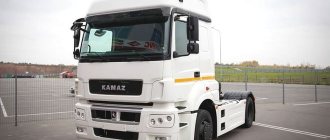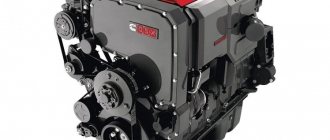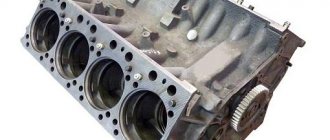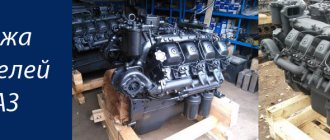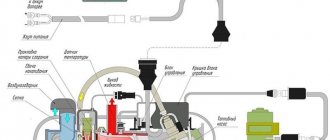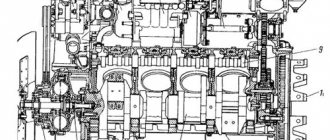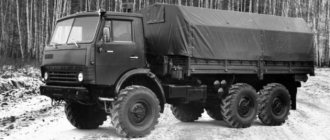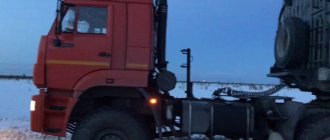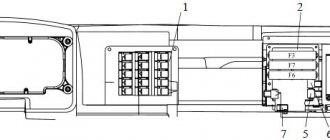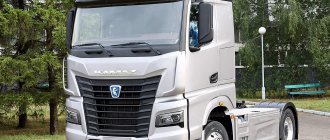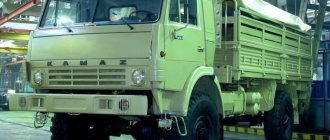- home
- Media center
- Articles
- Installation of YaMZ on KAMAZ
Menu
- News
- Articles
- Video materials
- Photo materials
- Publication in the media
- 3D tour
03.12.2021
The KamAZ dump truck has excellent chassis and body qualities, but the engine is its weak point. Despite the declared service life of 500,000 km, there are complaints about it. Technically, it can last this mileage, but after 200,000 km you can prepare for frequent failure. Even scheduled maintenance and constant revision of the KamAZ-740 modification engine cannot always guarantee reliable service for a significant mileage.
Therefore, for the long service life of the heavy truck, the option of replacing the power plant is being considered. Among the preferred options is the installation of YaMZ on KamAZ.
Preparation
The idea of installing a durable and more powerful engine on a dump truck can play a positive role, but for a competent approach it is extremely important to obtain comparable performance qualities. You should also prepare for the disadvantages:
- all YaMZ engines are essentially noisier, and the cabin will no longer serve as good insulation;
- The coolant will have to be changed more often as the radiator will become less efficient at removing heat.
Installing YaMZ-238 on KamAZ requires taking into account two key points:
- This engine has more power, so a number of other parts associated with it will need to be replaced.
- Dimensions exceed the original KamAZ engine.
As for power, you should also pay attention to the modification of the YaMZ-238 engine. If this is the basic version of 330 liters. s., then there will be no special advantage in traction over the KamAZ-740. If YaMZ is installed from a Ural-4320 military truck, that’s a different matter.
When starting to install the YaMZ-238 engine on KamAZ, it is worth resolving the following issues:
- Transmission.
The Kamaz gearbox will weaken in relation to the engine in each subsequent gear, and at the 5th stage the efficiency will drop to 15%. As a result, it will “eat up” up to 10 km/h (on a dirt road). The best option is the YaMZ-236 gearbox.
- Exhaust pipe.
You can forget about the basic solution. It will need to be heavily redesigned. It is better to give preference to exhaust manifolds from the MAZ-500. They assemble perfectly with a muffler from KamAZ.
At the exit, after installing the YaMZ engine, the KamAZ cab will “rise” by 10 cm. To do this, you will need to prepare other brackets for the cab. Many other fasteners will also require modifications, and some elements of the power plant will need to be freed up.
Even before installation, it is recommended to immediately redo the radiator. It is best to install “Mazov” pipes. If problems arise during reinstallation, you can rotate the diffuser.
KAMAZ with YaMZ engine
I’ll tell you a little about KAMAZ trucks with YaMZ engines. Why do they love MAZ????? For its indestructible engine, either an eight or a six. KAMAZ is very easy to maintain, which is called “on its knees.” So, if you create a KAMAZ with a YaMZ engine, you get an ideal hybrid of the “Soviet” automobile industry. Of course, everything depends on the cargo being transported, or rather its tonnage, and the nature of the ride, either long-distance or rough terrain. And here the choice is small, literally between three modifications of the Yaroslavl engines YaMZ 236 M2, YaMZ 238 M2 and YaMZ 238 D1. The remaining models, IMHO, are already inferior in their reliability, uninterrupted operation, maintainability and other ... features). Plus, when mated to a KAMAZ gearbox and a YaMZ engine, its “nobility” tends to 100%. Many still remember “those” times when the KAMAZ gearbox was converted from the 15th to the 152nd. Literally, one could forget where IT stands and why IT is even needed.). Of course, I’m exaggerating, but in fact there were practically no breakdowns, by the way, the KAMAZ gearbox was not developed by KAMAZ OJSC)))), and the 740 engine was invented by the Yaroslavl people, but somehow the engine was not a success...... So what am I talking about? History….. Rather, this is of no interest to anyone; many are more concerned about the YaMZ engine on KAMAZ, its “behavior” on the “tank”.
Excerpt from the website www.kamac.ru:
With equal rated power of engines produced by KAMAZ OJSC and YaMZ OJSC Avtodiesel, KAMAZ vehicles with YaMZ 238 and YaMZ 236 engines significantly benefit in throttle response and traction characteristics, since the engine power of YaMZ 238 and YaMZ 236 is achieved at significantly lower engine speeds;
The increased throttle response of the YaMZ 238 and YaMZ 236 engines significantly increases the traction characteristics of the KAMAZ vehicle when driving in particularly difficult road conditions and moving heavy loads; The service life of the YaMZ 238 and YaMZ 236 engines is 15% greater than the wear resistance of the KAMAZ engine, which allows the vehicle to be operated under the heaviest loads, and in the worst conditions guarantees stable mileage until the engine is repaired; Ease of maintenance and the possibility of using cheap types of motor oils significantly reduces the cost of operation and maintenance. maintenance of KAMAZ vehicles with YaMZ 238 and YaMZ 236 engines; Gearbox 152 (KAMAZ OJSC) with a divider allows you to select the best mode for various operating conditions, for example: dump truck operation, long trips, for transporting particularly heavy loads; Excellent maintainability of the YaMZ 236 and YaMZ 238 engines, ease of access to all components allows for routine and major repairs in the “field” conditions; Fast, guaranteed starting of the YaMZ 238M2-5 and YaMZ 236D engines in any frost allows the operation of KAMAZ trucks with the YaMZ 236 and YaMZ 238 engines in various climatic conditions; The oil change time in YaMZ 238 and YaMZ 236 engines has been significantly increased; The noise level of a KAMAZ vehicle with a YaMZ 238 and YaMZ 236 engine is reduced by 4-6 dB compared to KAMAZ engines, which provides enormous advantages when operating in urban conditions; With equal power, KAMAZ vehicles with YaMZ 238 and YaMZ 236 engines, at lower engine crankshaft speeds, emit >25% less unburned fuel and soot; It remains to say that I am simply in love with this KAMAZ, on which the Yaroslavl heart stands!
Engine Installation
The first step is to install the cardan with gearbox. As already mentioned, installing a KamAZ gearbox on a YaMZ engine is not preferable, but is acceptable (if there is no other option). Next, the YaMZ engine is placed on the KamAZ frame. The rear brackets, designed for the Kamaz engine, just need to be trimmed. The front one is more difficult - you will have to redo it yourself, having first calibrated the engine shaft:
- One jack is placed under the front of the engine.
- The second is located under the central part of the cardan.
Now, using jacks, you need to center the motor. At the same time, it is necessary to maintain the correct tilt of the cardan between the gearbox and the center differential. When the correct position of the engine relative to the frame is found, a front bracket is made for it. Afterwards the motor is fixed to the frame.
Next, the exhaust pipe is connected. The main problem is the location of the motor outputs. The best option would be the system from the MAZ-500, in which the exhaust manifolds are turned upward and extended. And a “KAMAZ” exhaust pipe with a coupling fits to it at the exit.
Specifications
The technical characteristics of the KamAZ 5511 are truly excellent, and it is not for nothing that the model is still used on construction sites today.
Body
In appearance, the element resembles a ladle, elongated in length. In the front part there is a protective canopy that protects the cab. At the base there are steel plates, from which the bottom is formed. For ease of operation, the bottom is widened and the front part of the body is at an angle. The body volume of the KamAZ 5511 dump truck is 7.2 cubic meters. m.
The machine is equipped with a heating system that prevents cargo from freezing at low temperatures.
The movement of the body is carried out hydraulically. The tipping mechanism has brackets with locking pins that securely hold the body in a raised state. To protect against overturning, the design has a cable with a spring.
The dimensions and volume of the KamAZ 5511 body make the model in demand today. And in terms of performance and reliability, it often exceeds the characteristics of imported equipment.
The hydraulic drive of the lifting mechanism consists of the following parts:
- Single-stage power take-off, operating from the gearbox. The control is carried out by electro-pneumatics, the controls are located in the cabin.
- Three-stage telescopic hydraulic cylinder, fixed by a hinged connection between the side and the subframe. The maximum lifting angle is 60 degrees. The mechanism also has a limit valve.
- 3 pneumatic electric valves and pneumatic wire system.
- Oil tank, pump, oil wires and control valve.
The weight of the KamAZ 5511 body without load is approximately 1780 kg. If you need to find out how much the KamAZ 5511 body weighs during operation, you need to add the weight of the cargo to this value.
Electrics
The car has two batteries connected to a 3-phase 800 watt generator. The “minus” from the batteries goes through the relay to the housing. The system produces 24 volts.
Electricity is used by various components of equipment: alarms, dashboards, heating and ventilation systems, lighting, starting mechanisms and other electrical equipment.
The KamAZ 5511 color wiring diagram is shown in the figure. The color matches the standard wiring.
Engine
The dump truck is equipped with a V-shaped eight-cylinder diesel engine with a capacity of 210 hp. With. without turbocharging. The installation is 4-stroke and runs on diesel fuel. The KamAZ 5511 engine is located in the front part of the vehicle, under the cab.
The cooling system is a closed configuration; its operation requires a constant supply of antifreeze. The unit has two thermostats and a cooler drive with an automatic fluid coupling.
The KamAZ 5511 engine provides a maximum speed of 80 km/h.
Fuel consumption
At a speed of 60 km/h, the fuel consumption of KamAZ 5511 is 27 liters per 100 km. This indicator is not ideal, but it does not affect the demand for the model (it is too irreplaceable). In addition, the KamAZ 5511 refueling tanks have a volume of 175 liters, which is quite enough for operation without refueling for one or two days.
Suspension
The suspension located in the front part is equipped with two longitudinal springs with sliding rear ends. The design is complemented by fingers with bushings made of rubber; they regulate the operation of the suspension shock absorbers in contact with the frame. The rear suspension has a single-axle balancer, the axle is fixed in a bracket. The rear wheels are dual and discless.
Steering
The machine has two rods: a longitudinal forged one and a transverse hollow one. Both have hinges in their design. To simplify turning, the system is equipped with a hydraulic booster with a vane-type gear pump and valve. The drive of the pump unit operates from the crankshaft of the motor.
Brake system
KamAZ 5511 has several types of braking mechanism:
- The main system is of a dual-circuit type (acts separately on the front and rear axles) - activated pneumatically by the brake pedal in the cabin;
- Backup - turns on when the main system fails, using a lever. Acts only on the rear axle;
- The parking brake is part of the backup system;
- Auxiliary brake - necessary for unloading and cooling the working mechanism, shuts off the flow of fuel and allows the equipment to brake smoothly.
Each KamAZ 5511 brake system operates in autonomous mode. The model is also equipped with an emergency brake release drive. Naturally, the car does not have an anti-lock braking system.
Other technical characteristics of KamAZ 5511:
- Transmission – manual 5-speed or 10-speed with divider
- Clutch – 2-disc with hydraulic drive and pneumatic booster.
- The front suspension is dependent, the rear is balanced.
- Body capacity - 7.2 cubic meters. m.
- Gross weight without load – 9.05 t
- Load capacity – 10 t
- Gross weight – 19 t
- Front suspension load – 4.4 t
- Rear suspension load – 14.6 t
- Power unit model – 740.11-240
- Power – 210 l. With. (146 kW)
- Crankshaft speed – 2600 rpm
- Ultimate torque – 667 Nm
- Volume – 10.85 l
- Cylinder size – 120 mm
- Compression ratio – 16
- Fuel tank volume – 175 l
- Voltage – 24 V
- Rechargeable batteries – 2x12/190 V/Ah
- Generator set – 28/1000 V/W
- Body elevation angle – 60°
- Main gear – gear ratio 5.43
- Brake drum diameter – 40 cm
- Brake pad width – 14 cm
- Wheel rim – 7.0-20 (178-508)
- Tire parameters – 10.00 R20 (280 R508)
- Turning radius – 9 m
Advantages and disadvantages
Advantages:
- Good maneuverability;
- Sufficient ground clearance;
- Possibility of quick repair of components;
- Availability of components;
- Exhaust body heating function;
- Quick lifting and lowering of the body;
- Affordable price;
- Ability to transport heavy loads;
- High-quality braking system;
- Good review;
- Possibility of operation at low temperatures;
- There is power steering;
- Small size for this type of equipment;
- No hood.
Flaws:
- The cabin is outdated both functionally and aesthetically: low quality finishing materials, uncomfortable seats, little space in front of the dashboard, but at the same time a lot of useless space;
- Not very powerful engine;
- High fuel consumption;
- Constant need to replace many spare parts;
- No all-wheel drive.
Component Assembly
After the power plant from YaMZ, you should start with the KamAZ gas distribution system. The converted radiator is first connected, and only then secured. Difficulties may arise when adjusting the nozzles - it is better to immediately unfold the diffuser. After connecting to the original water pipes, the radiator “will not reach” the fasteners, there are 3 ways to solve the problem:
- take water tubes from MAZ;
- digest the fastenings on the frame;
- use extension mounting bolts.
After the radiator there is an oil tank and a connection to the power steering. If preference is given to a non-original power steering pump from KamAZ (for example, NSh-100), the hoses will have to be ground off.
The starter is now connected. Here a problem is revealed - the transverse front bracket interferes with it. Because now the elements of the power plant are almost 10 cm higher. YaMZ fasteners are not needed, and they can be completely cut off (if there are no plans to put back the Kamaz engine in the future).
The last thing left to do is connect the generator, control sensors and other electronic components from KamAZ.
Cabin lift
After installing YaMZ on KamAZ, all brackets and bushings are redone. There are no suitable analogues from other heavy trucks. Using extension cords or other products that have many connecting nodes is unreliable in the long term. It is better to order fasteners from a mechanic and wait.
Two changes remain:
- Gearbox lever.
Ideally, install a backstage from SuperMAZ. You can keep your original one if you give it to the same mechanics to enlarge it.
- Steering cardan.
It is enough to lengthen the sleeve by 10 cm. Alternatively, it can be ground off from another cardan and welded.
Before lifting the KamAZ cab itself, it is important to pay attention to the electrics. This is due to the fact that the wiring and hoses will be stretched to the limit (but not critical, the main thing is to be careful).
The KamAZ cab is firmly fixed with boards that will hold it when replacing the brackets. It is more correct to perform the lifting in this order:
- first the front right brackets are redone;
- then the front left holders are changed;
- at this stage, a steering wheel drive with an extended bushing is installed;
- rear brackets are installed;
- The gearbox linkage is changing.
If, after raising the KamAZ cab, some brackets do not inspire confidence, you can additionally weld bushings nearby. The best way to test them is to drive them off-road a little. By paying attention to possible knocking and vibrations from the cabin, you can immediately identify weak fixation points.
